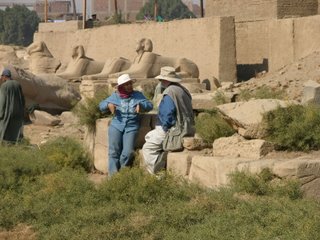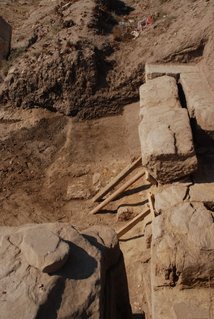 The 2007 season actually got underway on December 21, 2006, when we began cutting the vegetation that had grown up since last season. There wasn't much grass this year, but camel thorn blanketed much of the site. Its roots are shallow, but its sharp spines make it painful to remove.
The 2007 season actually got underway on December 21, 2006, when we began cutting the vegetation that had grown up since last season. There wasn't much grass this year, but camel thorn blanketed much of the site. Its roots are shallow, but its sharp spines make it painful to remove.
One of the workmen gingerly carries a basket of cut camel thorn past the fallen statue of Amunhotep III (usurped by Ramesses II) lying in front of Temple A in the northeast corner of the precinct (for maps of the site showing the major monuments go to the Mut Expedition pages at the Brooklyn Museum website).
 Our Supreme Council of Antiquities (SCA) Inspector this year is Ms. Mouna Fathi Sayed. She and I sit and discuss the site and the Expedition's plans for the season while the camel thorn is being cut.
Our Supreme Council of Antiquities (SCA) Inspector this year is Ms. Mouna Fathi Sayed. She and I sit and discuss the site and the Expedition's plans for the season while the camel thorn is being cut. One of our projects this year is to clear the north and south sides of Temple A's Forecourt. On the north side we began work where the Forecourt wall meets the temple's stone 2nd Pylon. On the left is half of a limestone statue of Tuthmosis IV (father of Amenhotep III of Dynasty XVIII) that we will have to move eventually. A more complete statue of the same king leans against the pylon. They were not original to the temple but were brought here at some point to be broken up.
One of our projects this year is to clear the north and south sides of Temple A's Forecourt. On the north side we began work where the Forecourt wall meets the temple's stone 2nd Pylon. On the left is half of a limestone statue of Tuthmosis IV (father of Amenhotep III of Dynasty XVIII) that we will have to move eventually. A more complete statue of the same king leans against the pylon. They were not original to the temple but were brought here at some point to be broken up.
 We found that two sandstone blocks of the north wall's upper course had slipped forward out of position as you can see in this photo looking west along the wall. The blocks supporting them are very badly deteriorated, so we put in wood supports until the lower part of the wall could be repaired.
We found that two sandstone blocks of the north wall's upper course had slipped forward out of position as you can see in this photo looking west along the wall. The blocks supporting them are very badly deteriorated, so we put in wood supports until the lower part of the wall could be repaired.
The restoration work was well underway and we had exposed more of the top course of the wall to the west by December 28, the last day of work before the 5-day break to celebrate the Eid el-Adha, one of the most important Muslim religious feasts.
 This photo looks south at the south side of the Forecourt during the 2006 season. The Lepsius Gate (see the 2006 dig diary) is to the right. Here the limestone foundations of the Forecourt's colonnade (foreground) and south wall have been exposed. Between the two is a slightly higher (and later) row of limestone blocks into which three large storage jars had been set.
This photo looks south at the south side of the Forecourt during the 2006 season. The Lepsius Gate (see the 2006 dig diary) is to the right. Here the limestone foundations of the Forecourt's colonnade (foreground) and south wall have been exposed. Between the two is a slightly higher (and later) row of limestone blocks into which three large storage jars had been set. This area was partially excavated in 1978 and became completely covered with blown earth in the intervening years, so that some of what we are doing is re-exploration. By December 28 we had once again uncovered the baked brick wall that runs parallel to the south wall of the Forecourt and is faced with small limestone blocks. To the south (rear) are the remains of a large mud brick wall that ran east from the Lepsius Gate. It has been robbed out by a large pit in the center. The baked brick part of the wall may, in fact, be a Ptolemaic or Roman Period repair to the wall's foundations or an extension of the wall to the north.
This area was partially excavated in 1978 and became completely covered with blown earth in the intervening years, so that some of what we are doing is re-exploration. By December 28 we had once again uncovered the baked brick wall that runs parallel to the south wall of the Forecourt and is faced with small limestone blocks. To the south (rear) are the remains of a large mud brick wall that ran east from the Lepsius Gate. It has been robbed out by a large pit in the center. The baked brick part of the wall may, in fact, be a Ptolemaic or Roman Period repair to the wall's foundations or an extension of the wall to the north. When we started work, the weather was cool but pleasant - perfect for digging. But when we saw the bank of clouds over the mountains to the west on the morning of December 23, we knew a change was coming.
When we started work, the weather was cool but pleasant - perfect for digging. But when we saw the bank of clouds over the mountains to the west on the morning of December 23, we knew a change was coming.Over the course of the morning the winds increased and the temperature dropped. And when the wind picks up, what it picks up is dust that blows in sheets across the site, making work and photography difficult. Looking through the Mut Temple's main gate you can hardly see the rear of the temple, and the sides of the work tents put up by the Johns Hopkins University team are billowing in the wind. It has been cold ever since, but at least the wind has dropped.
We got in a full week of work before the break for the Eid el-Adha. The rest of the Mut team arrives after Coptic Christmas on January 7, celebrated as a national holiday. Watch for the next posting in mid-January.
Richard Fazzini
Director, Mut Expedition







